The Catalyst Koha team is thrilled to celebrate the release of Koha 21.11. This release contains 4 new features, 196 enhancements and 388 bug and security fixes.
Every 6 months the Koha community does a major release, like 21.11. This is when most enhancements are added to Koha, so it’s always interesting to see what’s going to be available to libraries in their next upgrade.
Here are the Catalyst Koha team’s top picks from Koha 21.11:
Modifying your catalogue
Write protecting MARC fields based on source of import
This powerful new feature in Koha 21.11 enables librarians to define rules for specific MARC fields to be either protected (remain unchanged), overwritten, or appended to when different types of imports, or edits, happen in the staff client.
To define these rules, set the ‘MARCOverlayRules’ system preference to ‘Use’, and navigate to ‘Administration’ > ‘Catalog’ > ‘Record overlay rules’.
This feature is complex, and documentation for it has not yet been added to the Koha 21.11 manual, so if you’d like to read up on it now I’d suggest you take a look at these notes: https://gitlab.com/gnucifer/koha-manual/-/commit/593c5da008dbc4b074cac9dee167cce9a6dfc250#c5e2c75dc923f21c5b95185b2f350df00fec661f
An example of how a rule setup is, if you wanted to protect the 942$c (Koha biblio-level item-type) subfield from changing when biblios are edited you’d select: Module = ‘Source’, ‘Filter’ = ‘Staff client MARC editor’, ‘Tag’ = ‘942’, ‘Preset’ = ‘Protect’ (this will populate the ‘Added’, ‘Appended’, ‘Removed’ and ‘Deleted’ dropdowns).
Then whenever librarians edit biblios if they make changes to any 942 subfield those changes will not be saved – as you’ve ‘protected’ the 942 subfields

Add option for using a MARC modification template on a single record from the details page
Here’s a time saving enhancement, when you’re viewing a biblio record in the staff client click ‘Edit’ > ‘Modify record using template’. That will load the Batch record modification page, pre-populated with the biblionumber of the record you were just on. Select the MARC modification template (a set of changes to MARC fields) to apply to the biblio, and confirm.
I think this would be useful whenever you spotted a biblio missed off a list you put through the Batch record modification. Simply apply the same MARC modification template over the missed biblio individually.
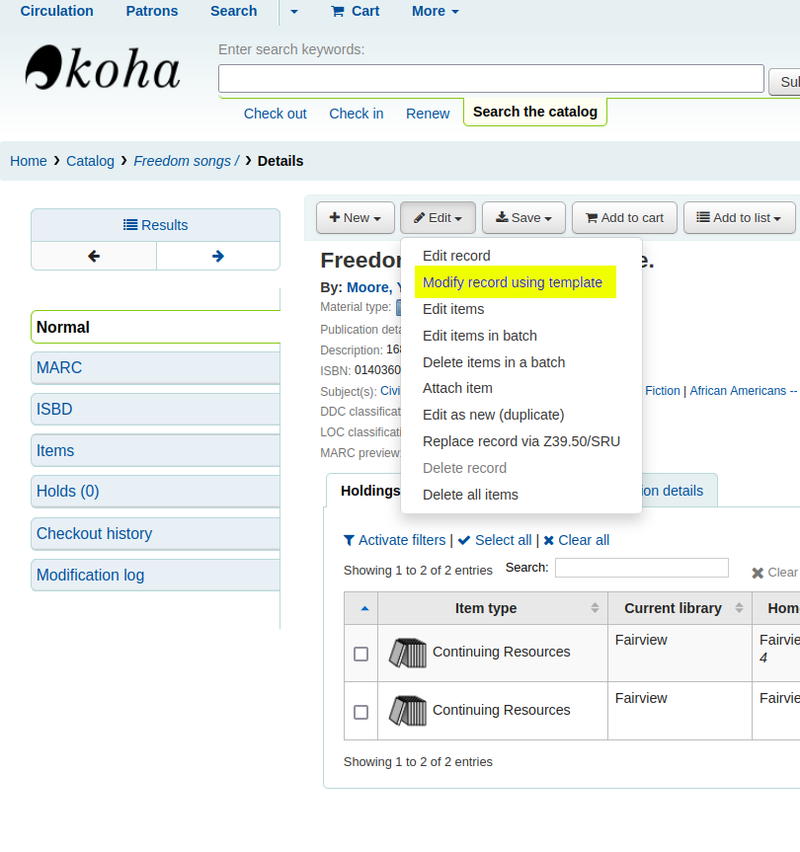
Check alert in cataloguing should be a static message
Cataloguing bibliographic records in Koha just got faster. Now when you catalogue using the Basic editor, and save with empty ‘Mandatory’ subfields, Koha displays a yellow ‘error’ box at the top of the page.
The great thing about this is each erroring subfield is now listed with a ‘Go to field’ link, taking the cataloguer to the subfield.
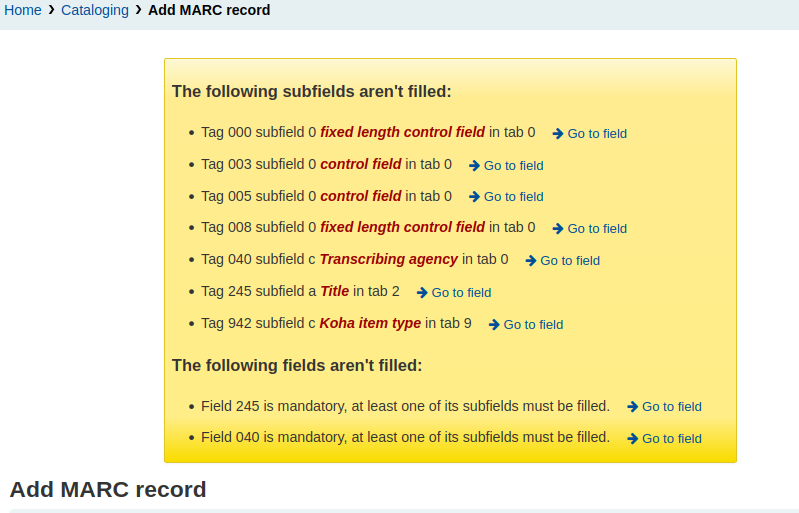
After setting a subfield value, to navigate back to the error box simply click on the yellow ‘Errors’ button in the toolbar at the top of the page.
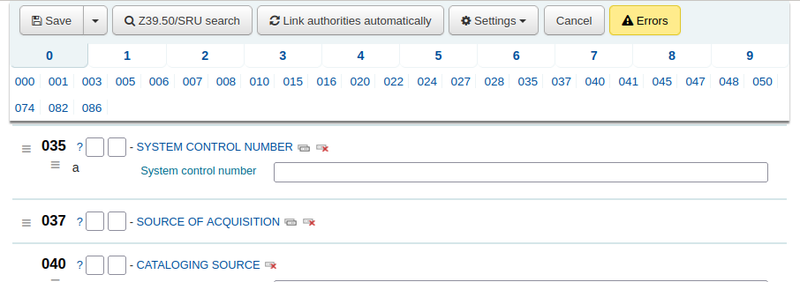
Course reserves
Allow bibs to be added to course without items
Increasingly library catalogues contain bibliographic records, without item records. Think of eBooks, often catalogued as a bibliographic record, with a link to an external source, and no attached items.
Until now the Course Reserves module has been limited to only adding item records as course reserves. Libraries had to resort to adding blank item records to eBook biblios, in order to add them as course reserves.
That workaround is no longer needed 21.11! Bibliographic records – both with, and without items – can now be added as course reserves. When adding course reserves, you can either enter an item barcode, or a biblio records’ biblionumber.
After adding a biblio to a course, patrons will see a link to the course when they view that biblio.
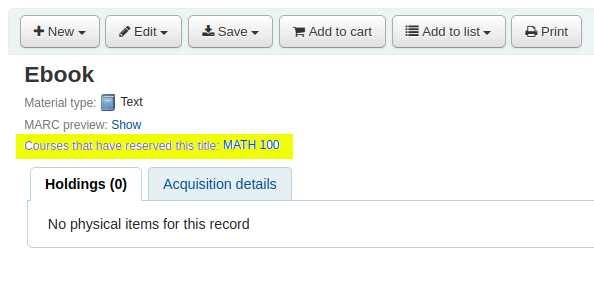
Acquisitions
Enhancements sure to make the acquisitions librarians amongst you happy are:
Make note fields from orders searchable
If your library uses the ‘Internal note’, or ‘Vendor note’ fields when adding items to a basket then you’ll be happy to know that you can search those fields in Koha 21.11.
Just navigate to Acquisitions > ‘Orders search’ > ‘Advanced search’, and that will load the Order search page:
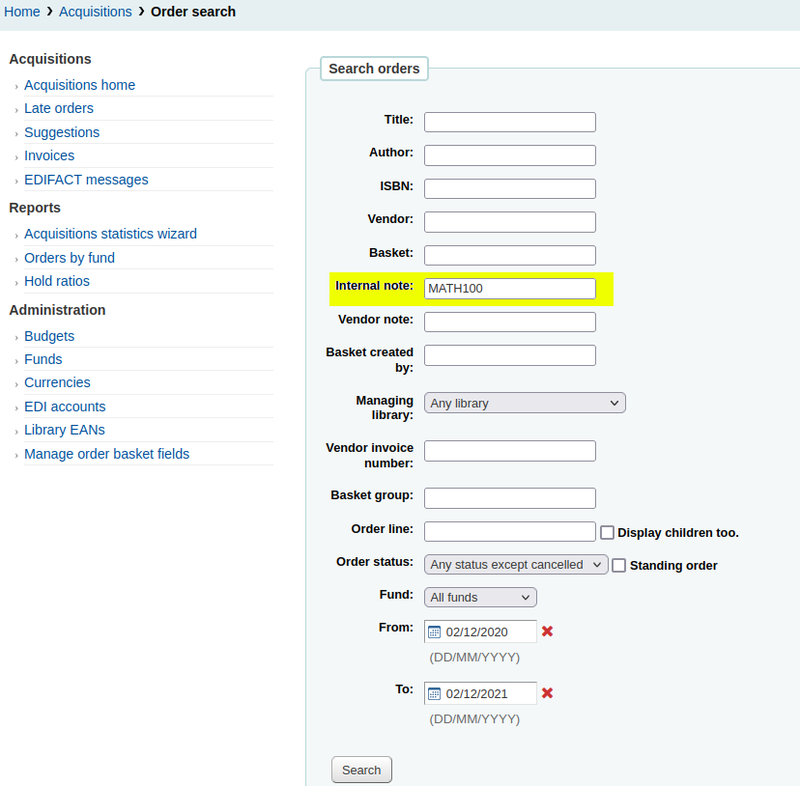
Enter a value into either of the new ‘Internal note’ or ‘Vendor note’ fields and perform a search. Any orders with note fields containing that text will be returned:

Add additional acquisitions logging
The acquisitions module is now more transparent! After you enable the AcquisitionLog system preference Koha will track changes, and who made them, to orders, invoices, budgets and funds.
You can then view these changes in the ‘Tools’ > ‘Log viewer’.
An example of when this might be useful is to track an order. From when the items were added to the basket, to the receival.
Also tracking changes to your budgets, and funds.
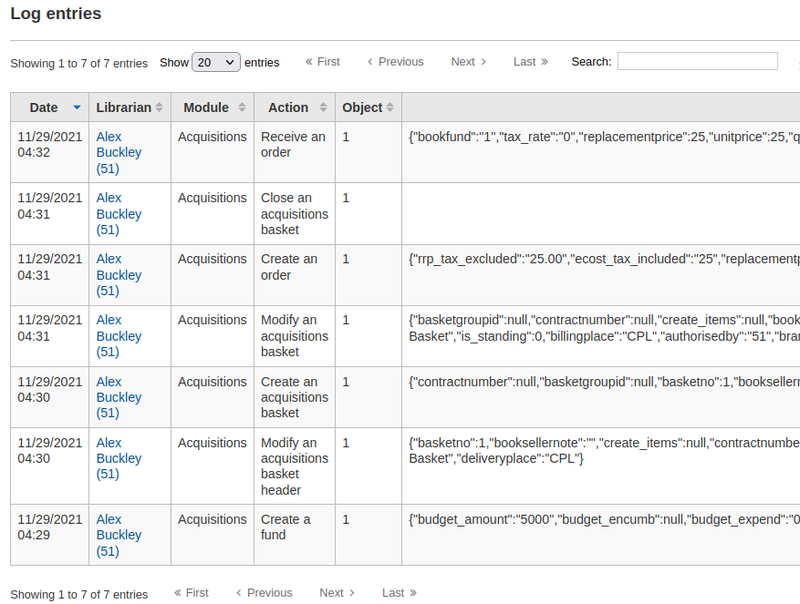
Circulation
Cancel holds in bulk
Another timesaver is the ability to cancel multiple reserves at a time. Simply click on a title from the staff client search results. Visit the ‘Holds’ tab and select the checkboxes of all the existing holds you want to cancel. Then click the ‘Cancel selected’ button.

You’ll be asked to give a reason for cancelling, then you click to confirm the cancellation.
The holds are not cancelled straight away, but are queued to be run as a background job. This is something Koha informs you of:

If you click on the ‘View detail of the enqueued job’ link you can see the progress of the background job.
It’s important to look at the ‘Progress’ and ‘Detailed messages’ values to determine if the holds are cancelled. The ‘Report’ value may say all holds have been cancelled when they actually haven’t.
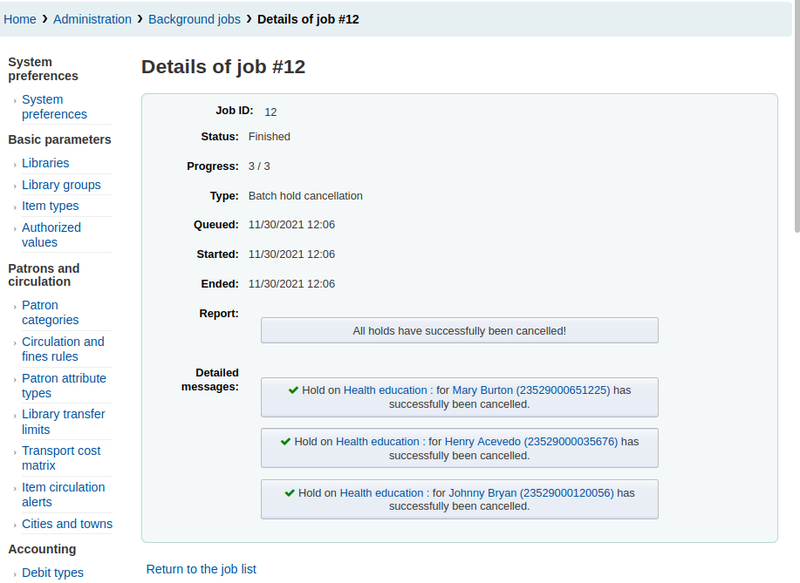
Patrons
Add ability to preserve patron field from being overwritten by import
Many academic libraries import patron CSV files, from their student management system, into Koha using the ‘Import patron’ tool.
Often-times these patron CSV files contain both new, and modified, patron records. So librarians want to update existing patrons in Koha, and add new patron accounts, if a cardnumber doesn’t already exist.
However, up till now when updating a patron all fields in Koha would be overwritten by what’s in the CSV file. In other words, there was no way to ‘lock’ fields from being replaced. 21.11 has solved that!
Now when importing patron CSV files you can use the ‘Preserve existing values’ field to stop a field being overwritten, if a matching patron is found.
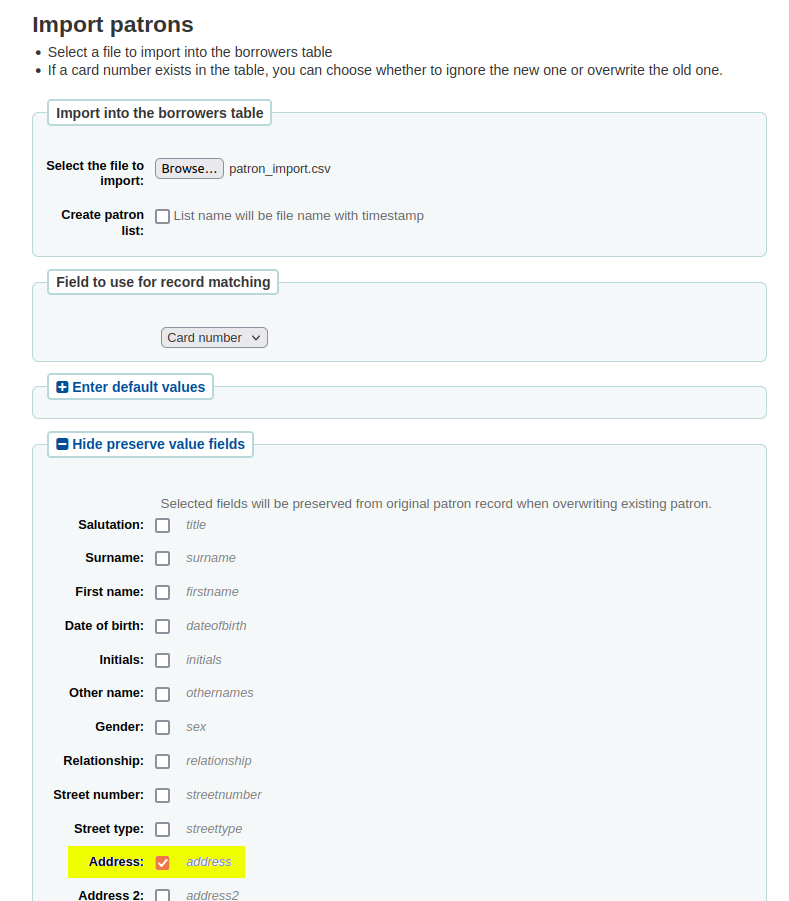
Split borrowers permissions into create/edit and delete
Libraries now have more granular control over what changes their librarians can do to patron records in the staff client.
Up till 21.11 one sub-permission permitted librarians to add, modify and delete patron accounts. That has now been split into two. The ‘edit_borrowers’ permission covers adding and modifying patrons, whilst the ‘delete_borrowers’ is needed for librarians to remove patron accounts.

Notices
Add 'Hold reminder' messaging preferences
Koha is so configurable by librarians, and it’s now even more configurable by patrons too. In 21.11 patrons can now control if they receive Hold reminder email and/or SMS notices.
The Hold Reminder notice was added in Koha 21.05. It’s intended to notify patrons that their reserved items are still awaiting pickup after X number of days waiting. That number of days items have been waiting is set on the Koha server.
Now when patrons login to the OPAC, view their account, and select ‘your messaging’ there’s a new ‘Hold reminder’ message setting. If they don’t want to receive the notice all they need to do is untick the checkboxes.
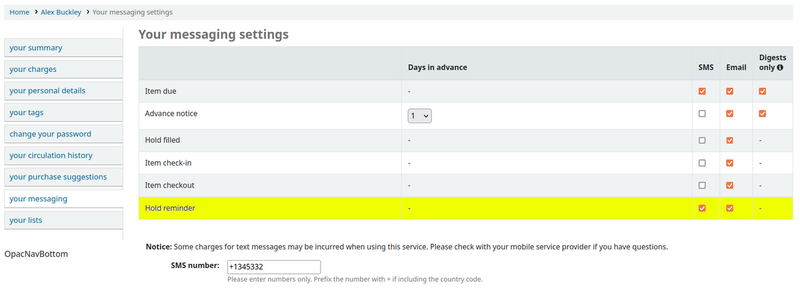
Note: There was a problem with this enhancement in the Koha 21.11.00 release - it did not correctly add the Hold reminder to the messaging preferences. You’ll want to wait until 21.11.01 for a follow-up fix for this.
OPAC
Convert OpacNav and OpacNavBottom system preferences to the Tools module
The last of the OPAC home page editable regions (OpacNav & OpacNavBottom) have now been shifted from system preferences into the Tools module.
The Koha community has been moving editable regions into Tools since Koha 19.05 (in 2019), so it’s great to see this work has finished for the OPAC home page!
Some of the benefits of shifting these content regions to Tools are:
1) You can queue custom content to display on the OPAC in the future – By setting the ‘Publication date’ and ‘Expiration date’ values you can create OPAC content when your workload is low, then queue it to automatically display in the future.
2) You can now add custom OPAC content for each language installed on your Koha instance – For example, you can add English New Zealand and Te Reo Māori OpacNav content, as long as those languages are installed on your Koha. Then the OpacNav content that displays will be determined by whatever language the OPAC user has enabled.
3) You can use a user-friendly free-text editor to insert tables, images, links and styling to your content without needing any HTML or CSS knowledge.
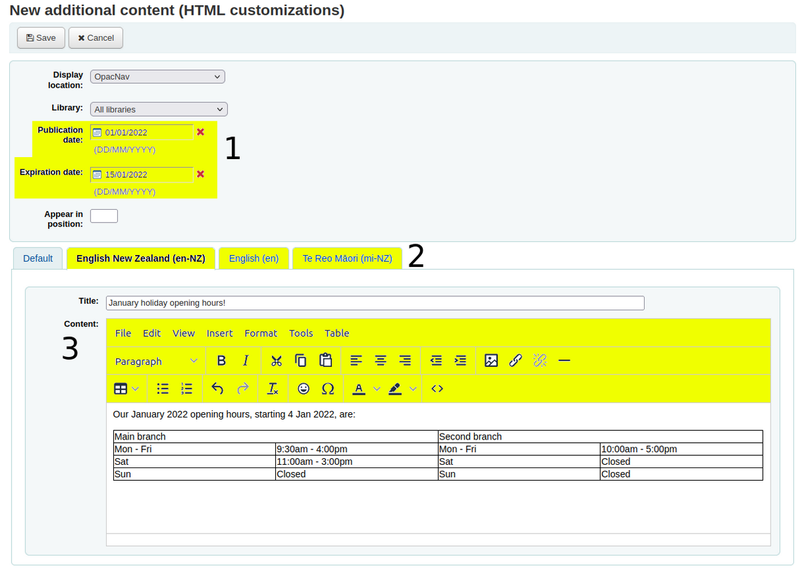
There’s another new page in the Tools module to edit the editable regions. Tools > HTML customizations.
Tip: When creating content make sure to add text into the ‘Title’ and ‘Content’ boxes, otherwise it will not save successfully.
Accessibility: OPAC - breadcrumbs should be more accessible
Our own Wainui Wikita-Park has been working hard to improve the accessibility of Koha since she started earlier this year.
This enhancement makes screen-readers describe breadcrumbs in the OPAC more succinctly and logically to vision impaired users. Breadcrumbs show users where the webpage they’re currently on fits into the site hierarchy. You can think of a site hierarchy like a file path.
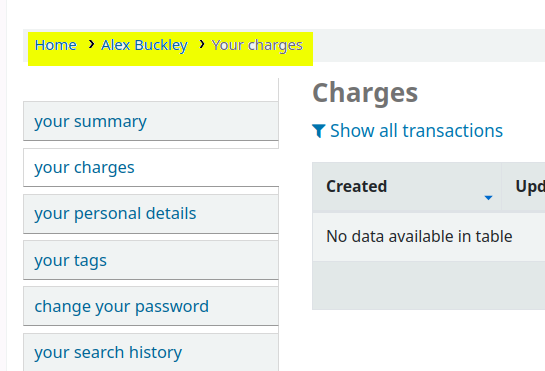
New API endpoints
Does your organisation use a student/staff management system for managing users, or a discovery platform as the search interface? If yes, then you’ll find the Koha API endpoints useful!
API endpoints allow other systems fetch, add, and modify data in Koha.
Koha 21.11 has added several new endpoints. Patrons can now create, view and delete purchase suggestions using the api/v1/suggestions endpoint.
Where this comes in handy is if your patrons interact with a discovery platform, like VUFind, rather than using the Koha OPAC. Patrons could create a purchase suggestion in VUFind, and have it automatically created in Koha for library staff to process. Similarly, patrons could view their Koha purchase suggestions within VUFind.
If you wanted to test out Koha API endpoints you can use a browser plugin like RESTED (Chrome: Chrome: https://chrome.google.com/webstore/detail/rested/eelcnbccaccipfolokglfhhmapdchbfg Mozilla Firefox: https://addons.mozilla.org/en-US/firefox/addon/rested/ ) to send requests to endpoints, and view the output:
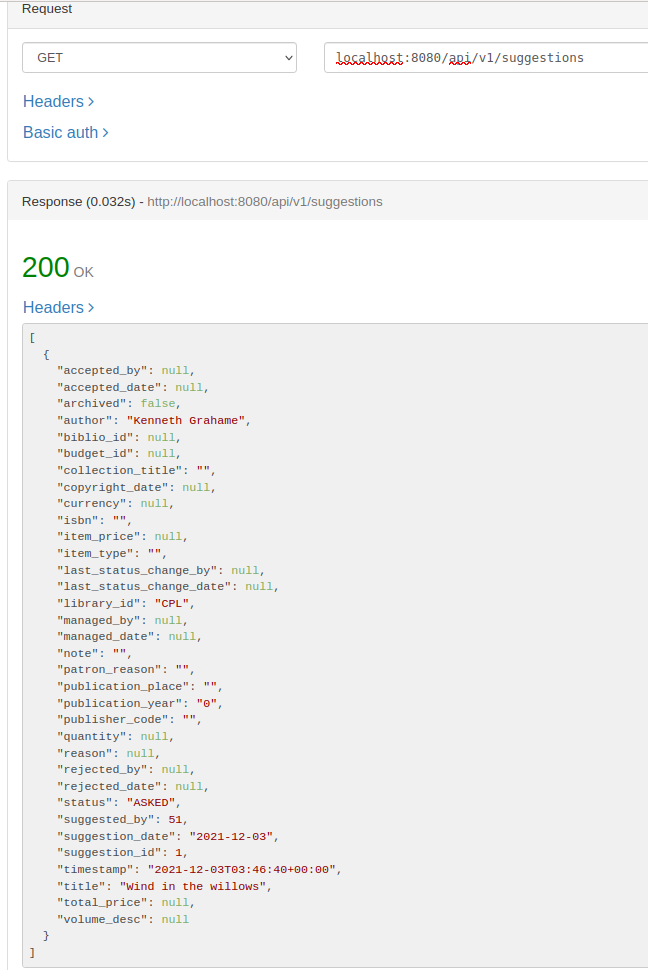
Searching
Elasticsearch is increasingly being adopted by libraries as their Koha search engine. It’s fast, configurable by librarians, and can be managed using other open-source visualisation systems like Cerebro ( https://github.com/lmenezes/cerebro ).
21.11 has made it even more useful. You can now search more MARC subfields with Elasticsearch including:
- 050a
- 245b, and 245p
- 246$c
- 710 and 711
- 800$t, 810$t, 811$t, and 830$a
Read more about the 588 features, enhancements, and security and bug fixes of the 21.11 Release on the Koha Community Website.
Written by Alex Buckley, Catalyst Koha Developer.
Catalyst Koha
If you have any questions or comments about this News item, or would like some support with your Koha instance, you are welcome to email us at [email protected] (New Zealand) or [email protected] (Australia).
Follow Catalyst Koha on Twitter!